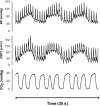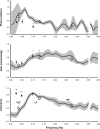Dynamic cerebral autoregulation during repeated squat-stand maneuvers
- PMID: 18974368
- PMCID: PMC2636935
- DOI: 10.1152/japplphysiol.90822.2008
Dynamic cerebral autoregulation during repeated squat-stand maneuvers
Abstract
Transfer function analysis of spontaneous oscillations in blood pressure (BP) and cerebral blood flow (CBF) can quantify the dynamic relationship between BP and CBF. However, such oscillation amplitudes are often small and of questionable clinical significance, vary substantially, and cannot be controlled. At the very low frequencies (<0.07 Hz), coherence between BP and CBF often is low (<0.50) and their causal relationship is debated. Eight healthy subjects performed repeated squat-stand maneuvers to induce large oscillations in BP at frequencies of 0.025 and 0.05 Hz (very low frequency) and 0.1 Hz (low frequency), respectively. BP (Finapres), CBF velocity (CBFV; transcranial Doppler), and end-tidal CO(2) (capnography) were monitored. Spectral analysis was used to quantify oscillations in BP and CBFV and to estimate transfer function phase, gain, and coherence. Compared with spontaneous oscillations, induced oscillations had higher coherence [mean 0.8 (SD 0.11); >0.5 in all subjects at all frequencies] and lower variability in phase estimates. However, gain estimates remained unchanged. Under both conditions, the "high-pass filter" characteristics of dynamic autoregulation were observed. In conclusion, using repeated squat-stand maneuvers, we were able to study dynamic cerebral autoregulation in the low frequencies under conditions of hemodynamically strong and causally related oscillations in BP and CBFV. This not only enhances the confidence of transfer function analysis as indicated by high coherence and improved phase estimation but also strengthens the clinical relevance of this method as induced oscillations in BP and CBFV mimic those associated with postural changes in daily life.
Figures




Similar articles
-
Arterial Pressure, Heart Rate, and Cerebral Hemodynamics Across the Adult Life Span.Hypertension. 2017 Apr;69(4):712-720. doi: 10.1161/HYPERTENSIONAHA.116.08986. Epub 2017 Feb 13. Hypertension. 2017. PMID: 28193707 Free PMC article.
-
Dynamic cerebral autoregulation in the old using a repeated sit-stand maneuver.Ultrasound Med Biol. 2010 Feb;36(2):192-201. doi: 10.1016/j.ultrasmedbio.2009.10.011. Epub 2010 Jan 4. Ultrasound Med Biol. 2010. PMID: 20045593
-
Assessment of dynamic cerebral autoregulation and cerebrovascular CO2 reactivity in ageing by measurements of cerebral blood flow and cortical oxygenation.Exp Physiol. 2014 Mar;99(3):586-98. doi: 10.1113/expphysiol.2013.076455. Epub 2013 Dec 20. Exp Physiol. 2014. PMID: 24363382
-
Determinants of cerebral blood flow velocity change during squat-stand maneuvers.Am J Physiol Regul Integr Comp Physiol. 2021 Apr 1;320(4):R452-R466. doi: 10.1152/ajpregu.00291.2020. Epub 2021 Feb 3. Am J Physiol Regul Integr Comp Physiol. 2021. PMID: 33533312
-
Spontaneous low-frequency oscillations in cerebral vessels: applications in carotid artery disease and ischemic stroke.J Stroke Cerebrovasc Dis. 2010 Nov-Dec;19(6):465-74. doi: 10.1016/j.jstrokecerebrovasdis.2010.06.001. J Stroke Cerebrovasc Dis. 2010. PMID: 20864356 Free PMC article. Review.
Cited by
-
Cerebral blood flow autoregulation is preserved after continuous-flow left ventricular assist device implantation.J Cardiothorac Vasc Anesth. 2012 Dec;26(6):1022-8. doi: 10.1053/j.jvca.2012.07.014. J Cardiothorac Vasc Anesth. 2012. PMID: 23122299 Free PMC article. Clinical Trial.
-
A nonlinear dynamic approach reveals a long-term stroke effect on cerebral blood flow regulation at multiple time scales.PLoS Comput Biol. 2012;8(7):e1002601. doi: 10.1371/journal.pcbi.1002601. Epub 2012 Jul 12. PLoS Comput Biol. 2012. PMID: 22807666 Free PMC article.
-
Dynamic cerebral autoregulation: different signal processing methods without influence on results and reproducibility.Med Biol Eng Comput. 2010 Dec;48(12):1243-50. doi: 10.1007/s11517-010-0706-y. Epub 2010 Nov 4. Med Biol Eng Comput. 2010. PMID: 21049290 Free PMC article.
-
CrossTalk opposing view: dynamic cerebral autoregulation should be quantified using induced (rather than spontaneous) blood pressure fluctuations.J Physiol. 2018 Jan 1;596(1):7-9. doi: 10.1113/JP273900. Epub 2017 Dec 5. J Physiol. 2018. PMID: 29207208 Free PMC article. No abstract available.
-
Cerebral blood flow in normal aging adults: cardiovascular determinants, clinical implications, and aerobic fitness.J Neurochem. 2018 Mar;144(5):595-608. doi: 10.1111/jnc.14234. Epub 2017 Nov 7. J Neurochem. 2018. PMID: 28986925 Free PMC article. Review.
References
-
- Aaslid R, Blaha M, Sviri G, Douville CM, Newell DW. Asymmetric dynamic cerebral autoregulatory response to cyclic stimuli. Stroke 38: 1465–1469, 2007. - PubMed
-
- Aaslid R, Lindegaard KF, Sorteberg W, Nornes H. Cerebral autoregulation dynamics in humans. Stroke 20: 45–52, 1989. - PubMed
-
- Birch AA, Dirnhuber MJ, Hartley-Davies R, Iannotti F, Neil-Dwyer G. Assessment of autoregulation by means of periodic changes in blood pressure. Stroke 26: 834–837, 1995. - PubMed
-
- Birch AA, Neil-Dwyer G, Murrills AJ. The repeatability of cerebral autoregulation assessment using sinusoidal lower body negative pressure. Physiol Meas 23: 73–83, 2002. - PubMed
-
- Bryan RM Jr, Marrelli SP, Steenberg ML, Schildmeyer LA, Johnson TD. Effects of luminal shear stress on cerebral arteries and arterioles. Am J Physiol Heart Circ Physiol 280: H2011–H2022, 2001. - PubMed
Publication types
MeSH terms
Substances
Grants and funding
LinkOut - more resources
Full Text Sources
Other Literature Sources
Medical

